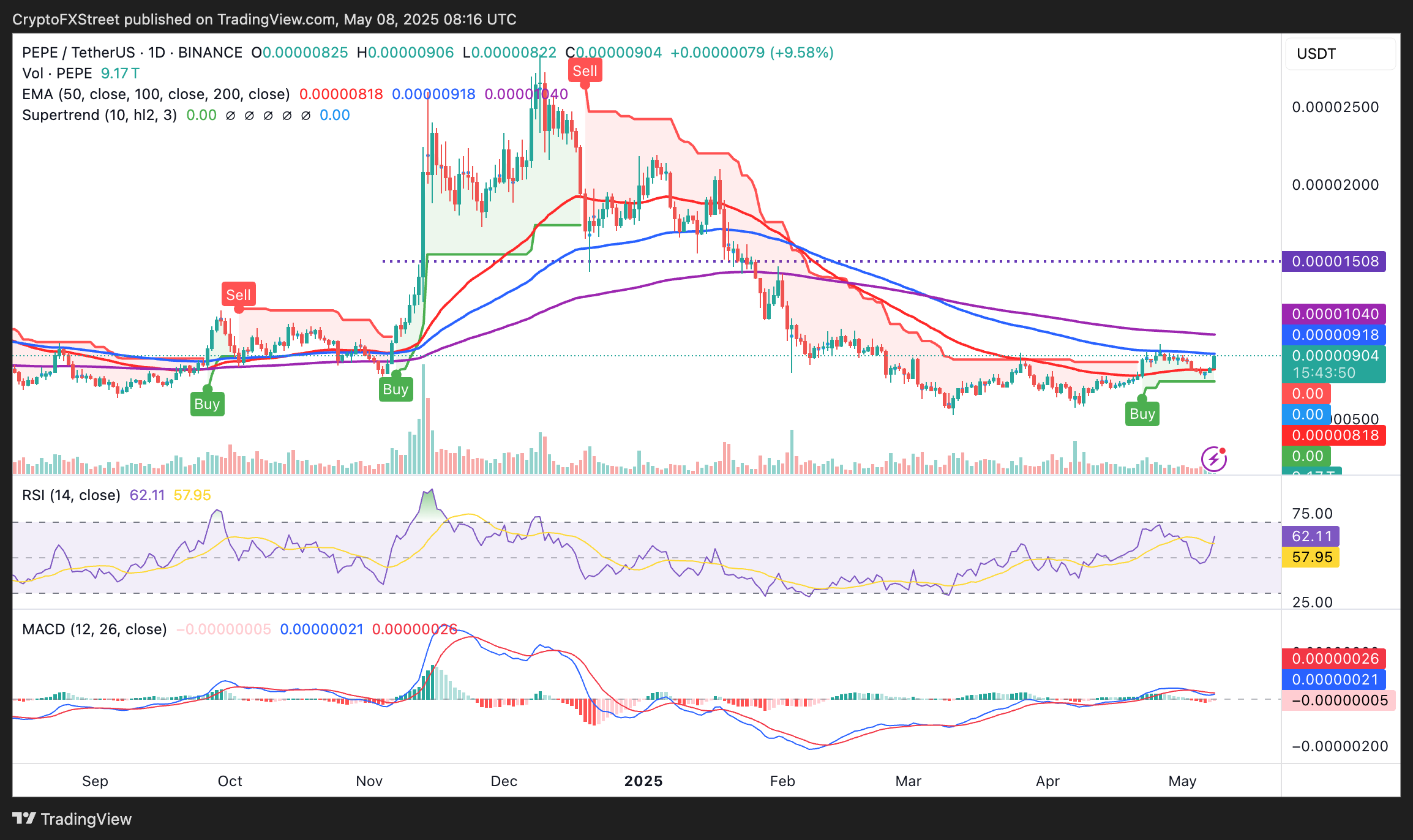Pepe price confirms buy signal as whales’ risk appetite skyrockets
- Pepe’s price increases alongside a Bitcoin-led rebound across the crypto market.
- Risk appetite surges as a whale scoops 500 billion PEPE worth around $4.36 million.
- Pepe’s uptrend steadies above the 50-day EMA support at $0.0000081, while bulls battle short-term resistance at $0.0000091.
Pepe’s price (PEPE) surges over 10% to trade at $0.0000090 at the time of writing on Thursday, mirroring a bullish wave in the wider cryptocurrency market. Investor interest appears to have started favouring altcoins, especially meme coins like PEPE. However, Bitcoin (BTC) is still King, bolstered by steady spot BTC Exchange Traded Funds (ETF) inflows and institutional adoption.
Bitcoin extends gains above $99,000 in the European session on Thursday, triggering recoveries across the market. This uptrend can be attributed to the Federal Reserve (Fed) meeting market expectations after leaving interest rates unchanged at the 4.25%-4.5% range and optimism ahead of United States (US)-China trade talks in Switzerland this weekend.
Moreover, news about a trade deal between the US and the United Kingdom (UK) could boost market sentiment, benefiting risky assets like cryptos. US President Donald Trump said on Wednesday that there will be a "big news conference" at 14:00 GMT on Thursday, concerning a major trade deal with representatives of a "big and highly respected country." An official at the UK government confirmed early Thursday that President Trump is expected to announce an outline of the US-UK trade agreement.
Pepe’s price picks up steam as whales increase exposure
Optimism for a broad-based altcoin season is fading amid liquidity crunches, heightened volatility and massive token unlocks, which create headwinds.
Isolated pumps among altcoins suggest that investors are likely focusing on the tokens with the potential to rally. At the same time, key narratives like meme coins, Artificial Intelligence (AI), and real-world assets (RWAs) are taking shape in this cycle.
This outlook has seen Pepe’s price steadily rebound from the tariff-triggered crash in April, backed by increasing demand from large volume investors. According to Lookonchain, a platform tracking large blockchain transactions, a whale purchased 500 billion PEPE valued at approximately $4.36 million. This particular whale holds a total of 2 trillion PEPE, worth roughly $17.42 million.
Lookonchain also highlighted that on April 30, another whale with a staggering $147 million in assets withdrew 1.5 trillion PEPE valued at $13.3 million from Binance. Withdrawals from exchanges often signal a bullish sentiment, as investors move tokens to self-custody wallets for long-term holding. This reduces potential selling pressure by decreasing the available supply on exchanges.
Santiment’s Supply Distribution metric emphasises the high risk-on sentiment, as the chart below shows that addresses holding between 10 million to 100 million have grown to account for 0.94% of the supply from 0.92% in February. If PEPE’s demand keeps growing, creating a stronger tailwind, its price could rise above $0.00001 or even hit $0.000015 in the near term.
 [10-1746692825118.53.06, 08 May, 2025].png)
Supply Distribution Metric | Source: Santiment
Pepe’s bulls tackle 100-day EMA resistance
Pepe’s price rebound seems unstoppable on Thursday after reclaiming the 50-day Exponential Moving Average (EMA) at $0.0000081 as support. Bulls are now knocking on the immediate resistance at $0.0000091, close to the 100-day EMA.
The Relative Strength Index (RSI) indicator’s upward trend toward the overbought region showcases the bullish momentum, increasing the probability of PEPE’s climb above the 100-day EMA.
The Moving Average Convergence Divergence (MACD) indicator teases a buy signal on the daily chart. This could manifest with the MACD line (blue) crossing above the signal line (red). If traders increase exposure to PEPE, the uptrend might last longer than expected, with near-term targets at the 200-day EMA around $0.00001 and $0.000015, a level last tested as support and resistance in January.

PEPE/USDT daily chart
However, failing to breach the immediate 100-day EMA hurdle at $0.0000091 or even the 200-day EMA resistance at $0.00001 could create instability, triggering sell-side pressure as traders adjust positions.
Profit-taking could escalate the probability of a trend reversal. Key levels to monitor for risk mitigation include the 50-day EMA at $0.0000081 and the April 7 low at $0.0000058.
Cryptocurrency metrics FAQs
The developer or creator of each cryptocurrency decides on the total number of tokens that can be minted or issued. Only a certain number of these assets can be minted by mining, staking or other mechanisms. This is defined by the algorithm of the underlying blockchain technology. On the other hand, circulating supply can also be decreased via actions such as burning tokens, or mistakenly sending assets to addresses of other incompatible blockchains.
Market capitalization is the result of multiplying the circulating supply of a certain asset by the asset’s current market value.
Trading volume refers to the total number of tokens for a specific asset that has been transacted or exchanged between buyers and sellers within set trading hours, for example, 24 hours. It is used to gauge market sentiment, this metric combines all volumes on centralized exchanges and decentralized exchanges. Increasing trading volume often denotes the demand for a certain asset as more people are buying and selling the cryptocurrency.
Funding rates are a concept designed to encourage traders to take positions and ensure perpetual contract prices match spot markets. It defines a mechanism by exchanges to ensure that future prices and index prices periodic payments regularly converge. When the funding rate is positive, the price of the perpetual contract is higher than the mark price. This means traders who are bullish and have opened long positions pay traders who are in short positions. On the other hand, a negative funding rate means perpetual prices are below the mark price, and hence traders with short positions pay traders who have opened long positions.

